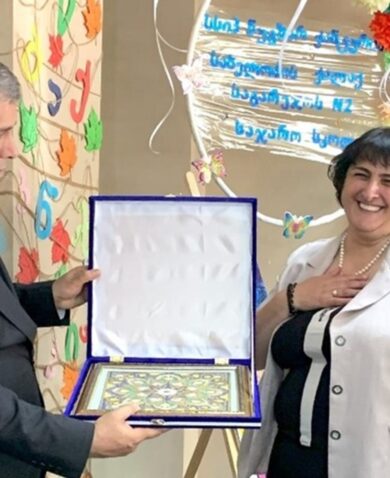Three Steps to Apply Trauma-Informed Approaches to EiE Programs
Educators and development practitioners can follow three steps to integrate TIA holistically into EiE programs: learn, apply, and sustain.
1. Learn.
Start by understanding the principles of TIA, inclusive education, and larger inclusive development strategies like HIA, within the context of your program. Conduct locally led assessments to identify mental health and inclusion challenges faced by students, young people, caregivers, and educators. Collaborate with local stakeholders to ensure the solutions align with the community’s cultural, social, and educational needs. If the program is already in place, perform programmatic audits to identify gaps in inclusion and trauma-awareness. Conduct student or community-centered learning and listening sessions, engage with local mental health and inclusion specialists where possible, and understand baselines for inclusion and mental health.
USAID’s Accès, Équité, Lecture, Rétention, et Redevabilité! Activity 1 (ACCELERE!1) in the Democratic Republic of the Congo demonstrates the importance of assessments in creating trauma-informed and inclusive learning environments. A qualitative evaluation in three provinces assessed gender activities and school violence prevention, leading to refined strategies and expanded efforts in other regions. Key actions included training over 17,000 educators on gender-sensitive pedagogy, establishing democratically elected Gender and Violence Monitoring Committees, and updating teaching materials to address inclusivity and gender-based violence.
By learning from the evaluation, ACCELERE!1 improved its approach to create safer, more inclusive schools. Ongoing assessments and community involvement ensured the sustainability of these practices, offering lasting support to higher-risk students in crisis settings.
2. Apply.
Develop a tailored strategy for improving inclusion and trauma-sensitivity by mapping activities that align with both TIA and inclusive education frameworks. Using HIA can support with the overarching strategy creation, which includes embedding trauma-sensitivity. SAMHSA’s Six-Principles of trauma-informed care can be embedded in programming and inclusion strategies, complemented with flexible mental health and psychosocial support activities, structured through frameworks like the IASC MHPSS Pyramid or USAID’s Positive Youth Development Framework.
The FCDO-funded Syria Education Program (SEP), known locally as Manahel, exemplifies this in its approach to implementation:
“The experience of implementing the Manahel programme both reinforces and augments our knowledge of trauma informed programme delivery by focusing on individuals’ sense of ownership through community engagement, establishing community networks to promote empowerment, and creating the conditions needed for safe and responsive adaptation” – Riham Jabbar, Deputy Technical Team Lead, SEP
Incorporating social-emotional learning (SEL) into curriculum development, integrating teacher well-being initiatives, and engaging mental health specialists, can strengthen a program’s impact on student well-being and learning outcomes.
Across the education continuum, programs should prioritize safe, inclusive spaces that reflect local customs and needs, including:
- Pre-Primary and Primary Education. Create emotionally supportive spaces where children feel safe. Train educators to recognize signs of trauma and use play-based learning to help children cope with stress. In the face of violence and destruction of some target schools, ACCELERE!1 strengthened the capacity of teachers to recognize and support students who were dealing with psycho-social issues. This included training educators on USAID’s Doorways Safe-Schools Curriculum, focusing on modules related to violence and school-related, gender-based violence; positive discipline; and code of conduct.
- Secondary Education. Incorporate SEL alongside academic subjects. Ensure that learning materials are inclusive, addressing diverse needs like language or disabilities, ensuring that no child is left behind.
- Tertiary Education. Offer mentorship and counseling to help students navigate trauma, social exclusion, and/or disabilities. Remove barriers to education for marginalized groups, such as financial or cultural challenges. The Syria Injaz project has seen success with its vocational training program, intentionally inclusive of those with disabilities, the displaced, and Al Hol returnees – or those with family members directly involved in ISIS.
3. Sustain.
Lastly, supporting educators and students long-term is key to making trauma-informed, inclusive education effective. Ongoing assessments and feedback are crucial to ensure mental health needs are being met. This also means keeping local referral systems for mental health services in place and continuously strengthening capacity through training and community engagement. At the heart of this is creating safe, student-centered spaces where children feel emotionally supported, with flexible learning options adapted to their needs. Case management systems that track students’ well-being, along with culturally sensitive environments, help sustain these efforts. Extending trauma-informed practices to the community, supporting teachers’ well-being, and involving caregivers are also part of the bigger picture. Additionally, remote learning can support education continuity when emergencies arise. By embedding these practices, we create a more resilient, supportive learning environment.
USAID’s Early Grade Learning (EGL) Activity in Nepal exemplifies how actively incorporating inclusion in education can yield significant benefits, offering a replicable model for EiE. Following the School Education Sector Plan and Equity Strategy of the Nepal Government, EGL is developing targeted approaches to create inclusive learning spaces. One key strategy was adopting Early Screening Tools with clear guidelines, including a standardized referral process to connect children with appropriate services. Introducing early screening and a disability data management system for children with disabilities, socio-linguistic mapping, and capacity-building for teachers with specific focus on Universal Design for Learning, introducing and administering accessibility self-assessment tools, and collaborating with Student Assessment Technical Committee (SATC) further strengthened inclusivity. EGL’s strategy to engage organizations of persons with disabilities and LGBTQI+ organizations and to support educators through Communities of Practice, is ensuring that municipal education plans sustainably prioritize inclusion. This approach offers a scalable model for other crisis settings.
The Path Forward to Resilient Learning Environments
By integrating trauma-informed approaches into EiE, development practitioners can build stronger, more resilient learning environments. Addressing mental health and inclusion challenges head-on ensures that all children, particularly those at the highest risk of ACE effects, can succeed. This not only enhances individual outcomes and resilience, but creates holistic, equitable, and sustainable educational systems that create bright futures for all.
Banner image caption: A group of Manahel-supported students engaged in a painting activity in a school.
Posts on the blog represent the views of the authors and do not necessarily represent the views of Chemonics.
































